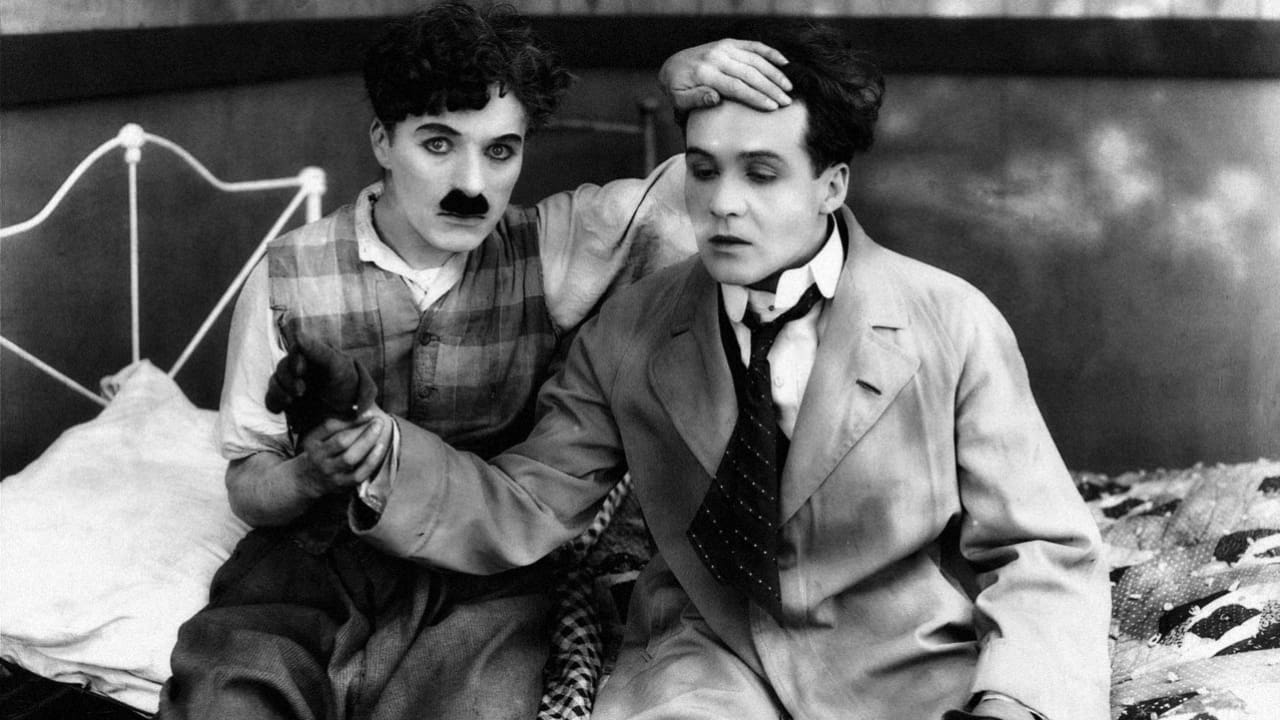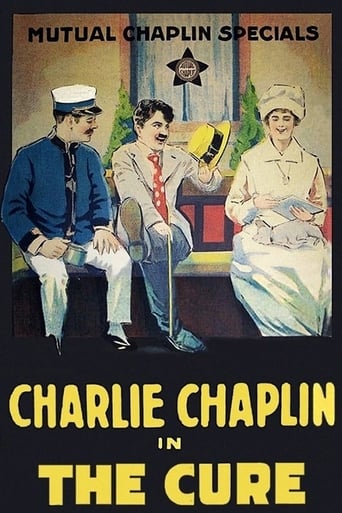

Disturbing yet enthralling
... View MoreA Disappointing Continuation
... View MoreI gave this film a 9 out of 10, because it was exactly what I expected it to be.
... View MoreOne of the film's great tricks is that, for a time, you think it will go down a rabbit hole of unrealistic glorification.
... View MoreAm a big fan of Charlie Chaplin, have been for over a decade now. Many films and shorts of his are very good to masterpiece, and like many others consider him a comedy genius and one of film's most important and influential directors. From his post-Essanay period after leaving Keystone, 'The Cure' is among the very best of his early output, one of his best from his Mutual period and one of his first classics. As said with many of his post-Keystone efforts, it shows a noticeable step up in quality though from his Keystone period, where he was still evolving and in the infancy of his long career. The Essanay and Mutual periods were something of Chaplin's adolescence period where his style had been found and starting to settle. Something that can be seen in 'The Cure'. The story is slight and slightly too simple but is at least discernible and is never dull, and does it while not being as too busy or manic.On the other hand, 'The Cure' looks good, not incredible but it was obvious that Chaplin was taking more time with his work and not churning out countless shorts in the same year of very variable success like he did with Keystone. Appreciate the importance of his Keystone period and there is some good stuff he did there, but the more mature and careful quality seen here and later on is obvious.'The Cure' is one of the funniest and most charming early efforts of Chaplin. It is hilarious with some clever, entertaining and well-timed slapstick and the charm doesn't get over-sentimental. It moves quickly and there is no dullness in sight. The second half is both hilarious and enchanting.Chaplin directs more than competently and the cinematic genius quality is emerging. He also, as usual, gives a playful and expressive performance and at clear ease with the physicality and substance of the role. The supporting cast acquit themselves well, with a charming Edna Purviance, their chemistry is sweet to watch, and Eric Campbell being both amusing and formidable.On the whole, great. 9/10 Bethany Cox
... View MoreTHE CURE (Mutual Studios, 1917), Written, directed and starring Charlie Chaplin, his tenth comedy short (20 minutes) for the Mutual studio, is one of his all time greats. For a title that indicates one to be set in a hospital with Charlie as an unruly patient who flirts with the nurses and drives his doctors crazy, in essence, it takes place in a sanitarium that wherever Charlie goes, trouble follows. For THE CURE, Chaplin breaks away from his traditional tramp character with derby and cane for straw hat, white suit and cane retained, stirring as much trouble as he can, intentionally or not, to those around him.The story opens at a resort with an assortment of female gossips gathered together seated around the health spring where enters the new resident, the drunken Charlie (Charlie Chaplin), arriving for a rest cure, to nearly fall into the water well on the ground. After being escorted to his room by a frail and thin bellboy, Charlie opens his crate that reveals an assortment of liquor bottles. Once the bottles are discovered with the bearded bellboy found drunk in Charlie's room, the superintendent (Frank J. Coleman) orders the bottles thrown out. The attendant (Albert Austin) takes him literally and throws the bottles out the window where they end up inside the water spring below. In the meantime, Charlie makes his rounds about the resort, encountering an attractive woman (Edna Purviance) being annoyed by the burly gout (Eric Campbell), thus, saving the day by becoming a big annoyance for the big man and hero to the girl. Later at the massage parlor, Charlie begins to have second thoughts of treatment when witnessing how the sadistic masseur (Henry Bergman) works on one of his customers. Following a series of unforeseen circumstances, Edna, whose about to meet with Charlie, discovers, to her disbelief, the refined residents and attendants having way too much fun for themselves in the lobby without knowing the reason why. And if that isn't enough!!!While there's not much plot nor character background development to go around, THE CURE is non-stop comedy, pure and simple. The carefully planned-out gags are enough to guarantee solid laughs with Chaplin stock character types in their proper roles for background support. As much as Chaplin is the sole attraction when it comes to both character and gags, Eric Campbell should not go unnoticed for his achievement in villainous comedy. Campbell, better known in later years as "Chaplin's Goliath," partakes in some of the greatest sight gags imaginable, including the revolving door, his reaction towards Charlie's misconducts involving his bandaged foot, his involvement with Charlie in both lobby and massage parlor, his trip down the stairs in a wheelchair, among others. Aside from Edna Purviance as Chaplin's frequent female co-star, other members of the cast include James T. Kelly, John Rand, Janet Miller Sully and Loyal Underwood.In the well documented three-part 1983 documentary, "Unknown Chaplin," there are some detailed moments capturing behind the scenes preparation for THE CURE, with Chaplin directing various sequences that were rehearsed and filmed, but not making it to the final print, and how changes to THE CURE developed into what has become one of Chaplin's finest gems, especially when properly scored on the musical soundtrack.When presented on public television in the sixties and seventies, this and other Chaplin's Mutual comedies (1916-17) were broadcast with sound effects and musical score taken from 1930s reissue prints. For THE CURE, underscoring consisted of current hit tunes of the day ranging from "Happy Feet" to "Happy Days Are Here Again." These reissue prints later became part of the Blackhawk/ Republic Home Video package dating back to the 1980s. In latter years, Chaplin's Mutual comedies were restored to accurate silent projection speed (25 minutes) with new orchestral score from KINO Video, the prints that have played on Turner Classic Movies (TCM premiere: December 6, 1999). After listening to different scores from various distributors, nothing comes off better than those orchestrated ones from Blackhawk for that bad scoring takes away the impact for such a fine comedy, considering how these twelve Chaplin shorts for Mutual are simply the cure for what ales you. (****)
... View MoreBefore Chaplin got into films, he was well known on the English stage for his roles playing a drunk, yet these roles are undeniably the weakest performances of his early film career. The movie opens with him stumbling all over himself as an exasperated bellhop tries in vain to lead him into a hotel. There is the obligatory mayhem involved in getting through a revolving door, which goes on for as long as it can. Chaplin seems to have an almost prophetic knack for milking a gag until there's nothing left! Once inside, what seemed like just another drunk movie turns delightfully into something else.Charlie reprimands a bellhop about to light a cigarette, and wags his finger at him, reminding him that smoking is bad for you health, and then casually opens a suitcase packed to the brim with every kind of alcohol imaginable. Needless to say, soon the bellhop doesn't seem to smoke much anymore, but spends most of his remaining screen time falling over drunk off of booze that he apparently "borrowed" from Charlie's suitcase. And by the way, seeing all of those bottles of 1917 alcohol reminds me of a long standing wish that I could have tasted Coca-Cola back in the old days, when it lived up to its name Soon Charlie checks into one of those establishments where you go to relax in the pool, spa, sauna, or get a massage, etc. I'm not sure what they're called in English, but I know that in Chinese it translates to "bath house." It's interesting to me to see what the place was like, because when I lived in America I never really spent much time in them, although I have been to some astonishingly nice ones in Colombia and China. It may be the third world, but I guess when a sizable portion of the population has no shower at home, public bathing spots are big business. There's an amusing scene involving a swimming pool and then a frighteningly vicious massage, which appears to be a mandatory experience in this particular bath house, and the massive masseuse chases Charlie all over the place, ultimately flat out fighting with him. But the best part of the film is that Charlie doesn't just play a drunk, we see him the next morning, and his actual dependency on alcohol is brilliantly portrayed. There is a scene where he charms a young woman off her feet, and she offers him a drink which at first he refuses, given that he's still recovering from the night before. But he takes a sip anyway, and then downs the rest of the glass and pours himself another, eventually taking the whole jug and drinking it down in front of the young lady, who is unimpressed. It mirrors the end of the film, which quite literally illustrates the message of the movie, which is that too much alcohol will lead to your life falling "in the drink."
... View MoreCharlie goes to a spa with a suitcase full of liquor, as he's obviously an alcoholic. Other guests are Eric Campbell, who has apparently broken his foot (you know what is stepped on numerous times in this film) and Edna, who takes the liking of both men.Funny scenes include several with a revolving door, in particular at the end, when Campbell takes a dive from his wheelchair into a small pool with special water... how did they manage to do that!The ending is pretty good as well, as 'The Girl' is Charlies cure for alcoholism. In short, nice little Chaplin (in which he isn't The Tramp for a change) flick, which I'll give 7/10.
... View More